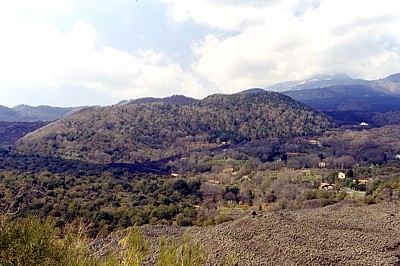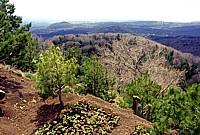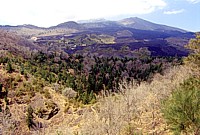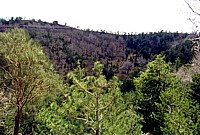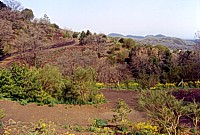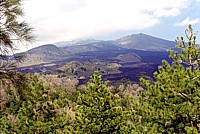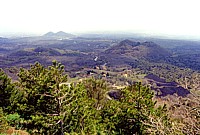| Etna
index |
||
| Geology | Geological history | Cones and craters |
| Eruptive characteristics | Eruptions before 1971 | Eruptions since 1971 |
| Etna and Man | References | Web sites |
| Weather forecasts | FAQ | Latest news |
Mamma
Etna's countless children
Monte Sona
S flank, 14.984559° E, 37.668957° N
Summit elevation: 1394 m
![]()
Among
the numerous flank cones that lie on the south flank of Mount Etna between
1100 and 1500 m elevation, Monte Sona is one of the geologically most
complex and interesting, although much of the geology is now hidden by
dense vegetation. Monte Sona is a complex of two large cones, each of
which has two craters, and on its south flank there is a line of younger
craters that probably erupted in 1536. What is most intriguing in this
area is that the alignment of vents on eruptive fissures is not radial
to the summit of Etna, but follows a NE-SW trend. This trend is evident
in the alignment of both the Monte Sona vents themselves and the nearby
1536 eruptive fissure system. Thus the two cones of Monte Sona are elongate
in this same direction, as are the vents within their craters. The larger
and more northeasterly of the two cones has a summit crater 180 x 250
m in diameter, with two vents separated by a low septum; the lower southwestern
cone has two smaller craters.
Due to the morphological complexities, Monte Sona is highly irregular.
Its larger northeastern cone rises about 130 m above its southern base
but only about 30 m above its northern base, where it has been surrounded
by the lava flow of 1910. The southwestern cone, which is about 80 m lower
than the northeastern cone, shows a similar asymmetry. A well-maintained
network of trails and dirt road allows very easy access to Monte Sona,
from where one can enjoy very impressive panoramic views of the upper
and lower southern flanks of Etna, with many of its pyroclastic cones
and lava flows of different ages, the most recent of which was added in
summer 2001.
I first visited Monte Grosso in early June 1998 but did not take photographs;
during my next visit on 22 April 2000 I did take photographs, many of
which are shown on this page, and a third visit was made on 31 October
2003.
Continue to Monte Manfrè
Copyright © Boris Behncke, "Italy's Volcanoes: The Cradle of Volcanology"
Page set up on 15 March 2004

